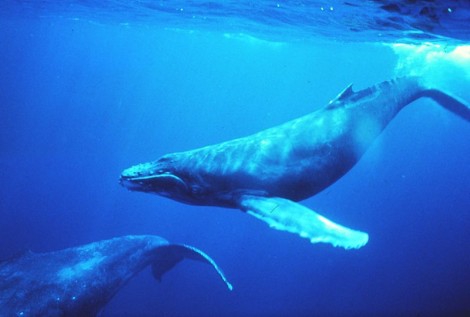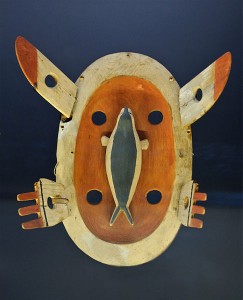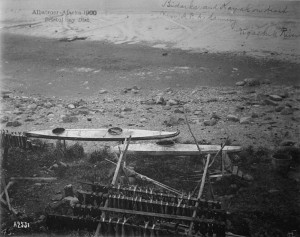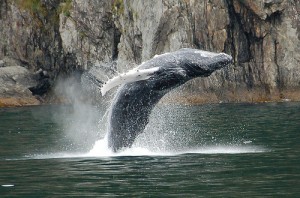 Each July, along the dappled stream banks of Kodiak Island, just off the Alaska coast, a weedy looking wildflower produces a few dark-blue hooded blossoms. There is nothing particularly memorable about the appearance of Aconitum delphinifolum. Its leaves are thin and rather spiky. Its scrawny-looking stem cannot hold the weight of its flowers: its neighbors keep it upright. But this eminently forgettable looking plant, a member of the buttercup family, possesses a dark secret. Aconitum delphinifolum contains a toxin capable of killing one of the world’s largest animals, a 40-ton humpback whale. Indeed, the local Alutiiq people have long understood this: their whalers once enlisted it as a lethal weapon.
Each July, along the dappled stream banks of Kodiak Island, just off the Alaska coast, a weedy looking wildflower produces a few dark-blue hooded blossoms. There is nothing particularly memorable about the appearance of Aconitum delphinifolum. Its leaves are thin and rather spiky. Its scrawny-looking stem cannot hold the weight of its flowers: its neighbors keep it upright. But this eminently forgettable looking plant, a member of the buttercup family, possesses a dark secret. Aconitum delphinifolum contains a toxin capable of killing one of the world’s largest animals, a 40-ton humpback whale. Indeed, the local Alutiiq people have long understood this: their whalers once enlisted it as a lethal weapon.
 Like other aboriginal people of the Northwest Coast, the Alutiiq long resided in complex societies that strongly resembled those of early agriculturalists. They hunted and gathered for a living, but they lived in a marine world of plenty, a world where hundreds of thousands of silverbright salmon collected at river mouths at predictable times each year, where 200 pound halibut could be reeled in by hook and line, where oysters and mussels and other shellfish thrived along the shore. Putting dinner on the table didn’t take a huge daily effort, so the Alutiiq and other Northwest people had something that many of their neighbors didn’t: time on their hands. So they carved masks and other intricate works of art and choreographed elaborate dances and winter ceremonies. And they lived in status-conscious villages ruled by wealthy nobles.
Like other aboriginal people of the Northwest Coast, the Alutiiq long resided in complex societies that strongly resembled those of early agriculturalists. They hunted and gathered for a living, but they lived in a marine world of plenty, a world where hundreds of thousands of silverbright salmon collected at river mouths at predictable times each year, where 200 pound halibut could be reeled in by hook and line, where oysters and mussels and other shellfish thrived along the shore. Putting dinner on the table didn’t take a huge daily effort, so the Alutiiq and other Northwest people had something that many of their neighbors didn’t: time on their hands. So they carved masks and other intricate works of art and choreographed elaborate dances and winter ceremonies. And they lived in status-conscious villages ruled by wealthy nobles.
But wealth and class were not the only roads to power among the Alutiiq. They deeply respected, even feared the men who ventured out into the rough waters of the North Pacific in small skin boats to hunt whales. The whalers were solitary men who generally kept their weaponry and their secrets to themselves, disclosing them only to young apprentices.
I became interested in these whalers a few weeks ago, when I read that two Alutiiq tribal members had discovered one of their ancient skin boats lying on a storage shelf at the Peabody Museum of Archaeology and Ethnology at Harvard. The boat, stitched together from the hides of female sea lions—combative males possessed hides that were too battered and scarred to be suitable—may now be the only traditional Alutiiq kayak left in the world. So the Peabody conservators are now poring over this nearly forgotten treasure, delving into the smallest details of its making. They discovered, for example, that someone stitched a lock or two of human hair to the prow. Why? No one seems to know. But the Alutiiq seem to have deemed the kayaks themselves as sacred: hunters often chose to be buried in them.
 Intrigued by all of this, I began reading about the Alutiiq whalers. To prepare for the hunt, the whalers removed themselves from their villages, sequestering in remote island caves. Far from the curious, they prepared the poison, boiling the roots of the monkshead plant and mixing the fluid with human fat. So deadly was the resulting mixture, they believed, that birds merely flying above could drop dead from the sky. When the unguent was finally ready, the men applied it to special spearheads fashioned from slate—thin, needle sharp weapons that could penetrate a whale’s thick skin. Then they summoned their spirit helpers, performing intricate rituals in the cave, rituals involving miniature carved wooden kayaks.
Intrigued by all of this, I began reading about the Alutiiq whalers. To prepare for the hunt, the whalers removed themselves from their villages, sequestering in remote island caves. Far from the curious, they prepared the poison, boiling the roots of the monkshead plant and mixing the fluid with human fat. So deadly was the resulting mixture, they believed, that birds merely flying above could drop dead from the sky. When the unguent was finally ready, the men applied it to special spearheads fashioned from slate—thin, needle sharp weapons that could penetrate a whale’s thick skin. Then they summoned their spirit helpers, performing intricate rituals in the cave, rituals involving miniature carved wooden kayaks.
In 1962, Alutiiq elder Ralph Demidoff told an old family story about a whaler to linguist Irene Reed. The hunter, the elder explained, took a young apprentice with him in a two-hatch kayak, instructing the boy to paddle close enough to the whale so that he could throw his spear. “I will be standing when I strike,” he said, “and you must steady the kayak so I can sink the spear deep.” In the story, the boy did as he was told, and as the whaler rose to his feet in the kayak, the whale surfaced. The frightened boy “saw the water swell up and break like surf right next to him, and there was a shattering noise as the whale blew the air out.” The child, however, remained cool-headed. He paddled smoothly, bringing the kayak alongside the great animal, and the whaler hurled his spear pointblank into the whale. Then man deftly twisted the shaft, breaking the spear.
 The whale seemed to shrug it all off, diving immediately. The boy said little: he was certain they had lost their prey. But the whaler knew that the animal’s fate was sealed. He had planted the spearhead in the whale’s flesh: the poison, an alkaloid known as pseudaconitine, would paralyze the leviathan’s powerful tail. In days, it would drown and wash ashore, and the village would feast on its blubber and turn its ropy intestines into waterproof attire.
The whale seemed to shrug it all off, diving immediately. The boy said little: he was certain they had lost their prey. But the whaler knew that the animal’s fate was sealed. He had planted the spearhead in the whale’s flesh: the poison, an alkaloid known as pseudaconitine, would paralyze the leviathan’s powerful tail. In days, it would drown and wash ashore, and the village would feast on its blubber and turn its ropy intestines into waterproof attire.
I confess that I am fascinated by such stories of ancient ingenuity. I think they tell us a great deal about who we are as humans and who we have long been. We are a species who can connect the dots, who can see the invisible link between an obscure wildflower blooming along a shady streambed and a village feast upon one of the leviathans of the deep.
Photos: Humpback whales, NOAA Sanctuary collection, Dr. Louis Herman; Alutiiq mask, Alaska State Museum, number inv II-A1-1511; Kayaks on Alaska beach, NOAA Photo Library, Historic Fisheries Collection, fish 7600; Humpback whale breaching, jdegenhardt.
What hs happened to your homepage? If this is a new look, it’s terrible? Or is there a bug? That’s my last word on . . . something!
Mike:
We haven’t made any recent changes to our homepage.
but how did they learn about “flower power” in the first place?
‘boiling the roots of the monkshead plant and mixing the fluid with human fat’
Where were they getting the human fat from?!!
Interesting article
Somehow the poison does not affect the humans eating the whale?
Also, what an awful long painful way to die. So much for the myth of the “noble” Native hunters.
These are all great questions.
Skeptico, the ethnographic and scientific literature doesn’t have anything to say about how the Alutiiq discovered the potency of these plants. But one could imagine some culinary experiment in an ancient Northwest coast household gone horribly wrong…
Mortisha, the Alutiiq kept the bodies of the important members of their society–most notably the whalers–in caves where they mummified naturally. For more on this, see Sven D. Haakanson’s fascinating book, Giinaquq: Like a Face, Sugpiaq Masks of the Kodiak Archipelago:
http://books.google.ca/books?id=W1QRLIbXlicC&pg=PA58&dq=Alutiiq+mummification&hl=en&sa=X&ei=zE6UT-aAIuaOiALh65j8Dw&ved=0CF0Q6AEwBw#v=onepage&q&f=false
According to several accounts that I read, would-be whalers took small slices of fat from these mummified individuals,who were believed to possess great spiritual powers even after death. On a prosaic level, the human fat acted as an adhesive, binding the poison to the spear head. On a spiritual level,it conjured up the protective spirit powers of the mummified whaler. All in all, hunting whales was a very sacred activity.
Dreamer, I wondered the same thing myself about feasting on the meat of a poisoned whale. I don’t know why the feasters weren’t poisoned as well. Can anyone out there shed any light on this?
Interesting article. I am intrigued by the lethal result of the wildflower on a huge animal like the humpback whale yet weak enough to leave the Alutiiq harmless when eating its meat. Beautiful.
I wonder if anyone has actually determined whether the toxin is indeed powerful enough to have the desired effect. This may, with all due respect, Heather — and no criticism intended — be a folk myth. As we both know, the storytellers and other guardians of Native lore suffered as badly as other tribal members from the effects of disease after European contact. Not only did their societies collapse but so did a great deal of their knowledge base. There’s a certain amount of revisionism at work here with more recent generations ascribing traits, history and behaviours to their ancestors which may not be accurate.
Mike: You raise some excellent points here. I certainly agree that Native American cultures lost some vital pieces of their knowledge base after contact. I am aware of archaeological evidence that corroborates the Alutiiq oral histories about whaling. But I think I will do further research on the toxin itself, and present all this information in a second post. Please stay tuned.